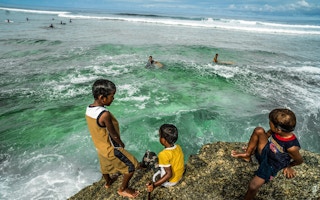Geoengineering will save us from the climate crisis, its champions insist. By using technology either to remove carbon dioxide from the atmosphere or to deflect some solar radiation away from the Earth, they claim, we can undo the damage wrought by humanity’s failure to reduce greenhouse-gas (GHG) emissions.
But while it certainly sounds like a convenient solution, there is no proof that it will work—and no telling what the side effects could be. In the view of Pacific islanders, it barely merits discussion.
Proponents of geoengineering are right about one thing: we are facing a climate emergency that demands radical and urgent action. The Intergovernmental Panel on Climate Change (IPCC) made that starkly apparent in October 2018, and reinforced the point last month, with its report on climate change and land.
Some major economies—including Canada, Ireland, the United Kingdom—as well as regions and cities have now officially recognised the scale of the crisis. The question is whether this will translate into a commitment to take the necessary action.
That certainly did not happen at last year’s UN Climate Change Conference in Katowice, Poland. Instead, leaders stuck to weak commitments that effectively allow for the continuation of business as usual—an outcome that was driven by countries in which fossil-fuel industries have tremendous political and economic clout. In most cases, they were the same countries that promote geoengineering solutions.
For Pacific islanders, who are on the frontlines of a climate crisis to which they have barely contributed, this persistently selfish and short-sighted approach has gone from disappointing to frustrating to infuriating. The 14 sovereign Pacific island countries account for only about 0.02 per cent of total global GHG emissions.
Yet, with many either possessing low-lying islands or composed entirely of low-lying atolls, they are extremely vulnerable to the effects of climate change, beginning with rising sea levels.
But Pacific islanders know better than to succumb to the siren song of geoengineering. In fact, they have been used as guinea pigs for the testing of powerful and risky technologies before, including nuclear weapons in the 1940s and 1950s, and are still suffering the consequences.
In the Marshall Islands, for example, the United States built (only in the 1980s) a massive concrete dome to house the deadly radioactive debris from such tests. But the structure was not built to last. As the dome degrades, the risks of radiation leaks are rising.
Geoengineering is not an entirely new topic to the Pacific. Governments in the region have already been targeted by researchers and proponents.
At a 2013 workshop in Suva, Fiji—organised by University of the South Pacific’s Pacific Centre for Environment and Sustainable Development and the Institute for Advanced Sustainability Studies—participants agreed that more research, broader awareness, and transparent debate on the topic were needed.
But, as participants emphasised, no climate engineering technology should be implemented unless it was proven to be a sufficiently safe option—and then only as a last resort. Even field testing should not take place without enforceable regulations and governance structures.
Most importantly, Pacific countries agreed that geoengineering technologies should not be regarded as a substitute to radical global mitigation efforts, including major emissions cuts.
Yet, six years later, the debate is entirely different. More geoengineering research projects, proposals for experiments, and commercial applications are on the agenda.
“
Pacific countries agreed that geoengineering technologies should not be regarded as a substitute to radical global mitigation efforts, including major emissions cuts.
At the same time, mitigation efforts are sorely lacking—specifically in those countries where governments are turning their attention to geoengineering as an excuse for inaction. In effect, responsibility for the climate crisis is being deferred to future generations, especially in the developing countries that have done the least to cause it.
In light of this imbalance, the Pacific Islands Development Forum’s position on geoengineering remains squarely in line with the Convention on Biological Diversity’s 2010 call for a moratorium—agreed to by 196 governments—on all geoengineering activities until “a global, transparent, and effective control and regulatory mechanism” is put in place.
The IPCC has made clear that the only way to address the climate crisis is with “transformation pathways” that slash emissions and protect and restore ecosystems, including through what is effectively a land-use revolution. Such pathways are mapped out not only in IPCC reports, but also in the 2015 Paris climate agreement.
This means replacing fossil fuels with renewable energy sources. It also means making the most of our planet’s natural capacity for carbon capture and storage, by protecting and expanding natural carbon sinks like forests, mangroves, and seagrass meadows.
As the IPCC report on land specifies, measures like expanding local and indigenous communities’ role in forest management would bring major benefits, as would a transformation of food systems to ensure sustainable agricultural practices and minimal food waste.
Most of the needed responses will contribute positively to sustainable development and other global goals. For starters, a healthier planet means healthier people: by causing respiratory illnesses, outdoor pollution results in around three million premature deaths per year.
Furthermore, the shift to renewable energy would help create large numbers of quality jobs—far more than the fossil-fuel industry offers. And this does not even account for the massive costs—associated, for example, with increasingly extreme and frequent weather events—that would be avoided if we mitigated climate change effectively.
The longer we delay, however, the more urgent the crisis becomes—and the higher the chances of reckless action.
Already, the rapid escalation in the effects of climate change is being used to justify risky outdoor geoengineering experiments that could have devastating and unpredictable environmental consequences, and that could put the world on a slippery slope toward deployment, without the necessary safety assurances or regulatory structures.
We know what we have to do—indeed, we have known for years. If all countries fulfill their responsibilities, we can respond effectively to climate change. But to protect humanity—beginning with ultra-vulnerable Pacific islanders—we must act now.
François Martel is Secretary General of the Pacific Islands Development Forum.
Copyright: Project Syndicate, 2019.
www.project-syndicate.org











